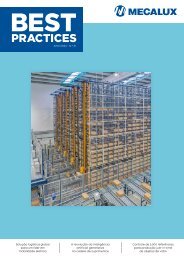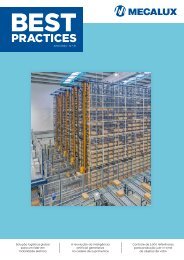Create successful ePaper yourself
Turn your PDF publications into a flip-book with our unique Google optimized e-Paper software.
Our experts I Structural Calculation<br />
How to calculate the structure<br />
of a conventional pallet rack<br />
What forces must be pondered when designing metal pallet racks? How do we verify that the structure<br />
will be suitable to withstand all loads? These and other <strong>issue</strong>s are those which should be taken into<br />
account in the design of this type of rack, with the goal of ensuring its stability and resistance, and<br />
therefore the overall security of the installations.<br />
The European EN 15512 norm, according<br />
to its definition, specifies the requirements<br />
for structural design applicable to conventional<br />
pallet racking (selective racks)<br />
manufactured from steel components,<br />
designed to store palletised unit loads and<br />
subject to essentially stationary loads. It<br />
has become the main benchmark on this<br />
matter, and provides additional technical<br />
information required for the implementation<br />
of the Eurocodes.<br />
In addition, designers must also provide<br />
for the EN 15620, EN 15629 and EN 15635<br />
standards as guides for the specifications<br />
of the storage system, the required tolerances<br />
during assembly and the safe operation<br />
of the installation.<br />
Likewise, conventional racks for palletised<br />
loads are metal structures, generally<br />
formed by components made out of thin,<br />
cold-formed, steel sheet metal. They are<br />
able to withstand heavy loads, while the<br />
installation is designed to be as lightweight<br />
as possible; consequently the rack’s own<br />
weight rarely exceeds 5% of the load stored<br />
in the facility’s interior.<br />
On the other hand, it is imperative that this<br />
type of installations for palletised loads be<br />
versatile, to be able to adapt to different<br />
load types. For this reason, the connections<br />
between the main parts of the structure<br />
must be adjustable, and quick and<br />
easy to assemble.<br />
The uprights of these structures usually<br />
have perforations along the entire profile,<br />
while the beams include connectors provided<br />
with hooks that fit into the perforations<br />
of these uprights.<br />
Basic structural<br />
components<br />
• Frames: are vertical pieces composed<br />
of two uprights joined together by beams<br />
and cross-ties forming a lattice.<br />
Close up of the<br />
joining of an upright<br />
and a beam<br />
• Uprights: these tend to be cold-profiled<br />
components of thin sheet metal, with<br />
open sections and are always perforated,<br />
which makes them prone to distortion and<br />
torsional type sagging.<br />
• Beams: are horizontal pieces that bear<br />
the burden of the pallets. These tend to<br />
be cold-profiled and have connectors on<br />
their ends for attaching them to frame<br />
uprights.<br />
• Connectors: are parts welded onto<br />
the ends of beams to attach them to the<br />
uprights. They are equipped with hooks<br />
that fit into the perforations of the<br />
uprights.<br />
154 <strong>Best</strong> <strong>Practices</strong>

















